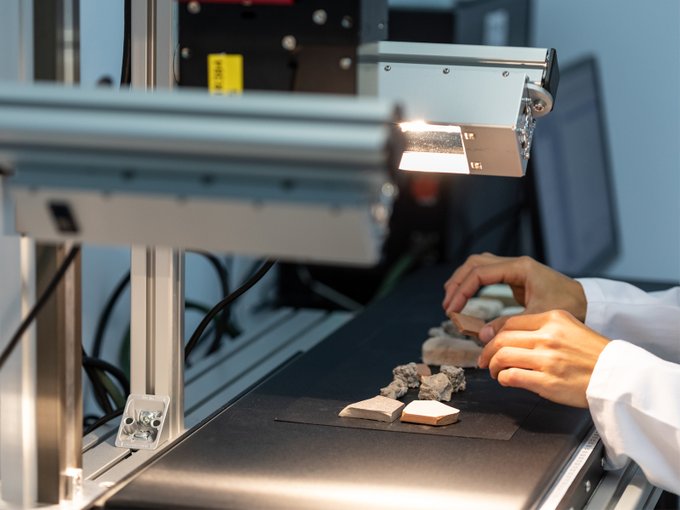Colruyt Group, a partner in the ICEBERG project, aspires to be a reference point for sustainable entrepreneurship and consumption.
The environmental impact of the buildings and sustainable material management are also part of this. To achieve its goal, the group is investing in innovative construction methods and materials, among other things. The Belgian retailer turned to VITO, that also forms part of the ICEBERG consortium, for tailor-made advice.
Sustainability has been a recurring theme in Colruyt Group’s activities for more than fifty years and their ambitions are far-reaching. Hilde Carens is Sustainable Building Materials project manager at Colruyt Group. As for their consumer products and packaging, they want to use as few primary raw materials as possible for their infrastructure too.
You’re aiming for low-impact shops?
Indeed we are. Since the construction sector is a major consumer of raw materials, we want to contribute with our portfolio as well, and commit ourselves to (re)valuing materials during the demolition, construction, renovation or extension of buildings.
As far as possible, we want to replace the use of primary raw materials with the reuse of existing materials and the high-quality recycling of raw materials released by demolition and dismantling work.
How will you go about building your shops in a completely circular way in the future?
When we demolish or renovate shops, we aim to leave nothing in landfill. So the first thing we had to do was get a picture of the reusable volume and purity in each material type that is released during demolition work for the construction of new branches or renovation work on existing buildings.
We called in VITO’s aid for this. Together, we monitored the selective demolition of a shop, a car park and 2 adjacent houses. We prepared detailed sheets for all the types of material we harvested. These show whether those materials can be recycled and, if so, how. This way, we’re creating a kind of library of material sheets and the corresponding logistical network. Over time, we want to have an overview of all the materials used in our own buildings (shops, offices, distribution and production centres), their ‘life cycle’ and their environmental impact.
What was the added value of working with VITO for this?
“When we demolish or renovate shops, we aim to leave nothing in landfill”
In terms of recycling rate for our operational activities (points of sale, depots and production centres), we already have a lot of detailed information: In 2019, we achieved a record recycling rate of 83.98% for our own proportion. We’re aiming to scale this up every year, with the ambition of having a recycling rate of at least 85% by 2021. We’re already doing well in principle, but there was still a ‘blind spot’ for building materials.
We didn’t have the necessary expertise ourselves with regard to the knowledge and processing in the chain of all the materials, so we had to find this outside the company in order to go one step further. That’s how we ended up with VITO. They have a track record, a lot of experience and already an extensive network. They know where to go with certain materials – that you can’t go to traditional dismantling companies with – for high-quality recycling instead of downcycling.
That was your first project with VITO. Did it lead to other initiatives?
Definitely. A study has been launched to review our circular potential and to see whether the non-residential building materials we use can be integrated into the Total Environmental impact of Materials optimization tool (TOTEM) . It is now in its final phase.
In addition, along with VITO, we are participating in the European ICEBERG project under Horizon2020. ICEBERG (circular economy of building materials through urban mining) aims at developing, demonstrating and validating advanced technologies for the production of clean secondary raw materials through 6 circular case studies spread across Europe. The various kinds of materials are all of interest to us. Nevertheless, we are test partners for recycled concrete products.
Which materials are you mainly looking at?
“In the European ICEBERG project, we are test partners for recycled concrete products”
We’re looking at all building materials, for the shell, finish and interior of our buildings. There’s a particular focus on materials with a high environmental impact or large used volume, for which limited reuse or recycling is used. We are aware of the fact that, with a portfolio of more than 600 buildings, our environmental impact is substantial. We want to take our share of responsibility.
Currently, this extends to concrete, aerated concrete, synthetic insulation, bitumen roofing, asphalt and metal sandwich panels. We’re investigating how we can make this a closed loop – and in terms of efficiency and business model, with as few extra actions as possible. So we’re looking at reuse first, rather than recycling.
If we notice that certain materials pose a bottleneck for reuse or recycling, we don’t just ignore that. We then review our designs and concepts with a view to the future in order to remove the bottlenecks in future projects, and to see whether the current materials can still be used internally or externally in a different way.
Colruyt Group owns a large building portfolio. Is circular construction feasible for smaller companies too?
Colruyt Group’s investment in in-house craftsmanship and the size of our portfolio give us some unique advantages. We understand that not everyone has that, so we consciously share our lessons learned through our collaborations and our networks. We’re actively working towards a profitable, circular economy by 2050.
I’m very grateful to be working within a team that’s allowed to work on sustainability full-time. Not every company has that opportunity. But I do think it’s feasible for everyone to strive for maximum circular potential – even for smaller construction teams – as long as you take it one step at a time and make it manageable. Some steps are easy to take. For example, choose simplicity and purity of materials, and involve stakeholders in the chain who pursue the same values.
We’re actively working towards a profitable, circular economy by 2050”
Where I do see a gap for further broadening of the market, even more for smaller players than for ourselves, is in central data management across Belgium of all players and all cycles within this field. That would make for a huge efficiency improvement for all of us.
What is your ambition for the future?
We’ll continue to focus on selective demolition, urban mining, innovative materials and concepts, in order to keep working towards a 100% circular potential for our portfolio and a positive environmental impact. We want to get to a point where no material is considered to be waste, but remains valuable for use by us or by others. We want to achieve a healthy closed ‘loop’ throughout the chain, through reuse or high-quality recycling.
ABOUT COLRUYT GROUP
Colruyt Group is a family business that has grown over three generations into a retail group with over 30,000 employees and a diverse portfolio of food and non-food formulas in Belgium, France and Luxembourg. In addition to its well-known supermarket chains, the group also comprises some 20 other companies, including a bottling plant, a coffee roasting plant, a chain of bicycle shops, a petrol station network (where electricity and CNG are also available), the offshore wind farm Parkwind, etc.
Note: This interview was first published on VITO´s website





